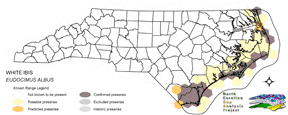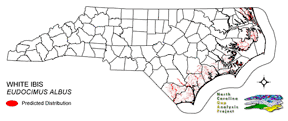
| Taxa: |
| Order: |
| Family: |
| Aves |
| Ciconiiformes |
| Threskiornithidae |
| NatureServe Global Rank: |
| NatureServe State (NC) Rank: |
| G5 |
| S3B,S3N |
| Federal Status: |
| NC State Status: |
| --- |
| W2 |


| Land Unit |
| US Fish & Wildlife Service |
| US Forest Service |
| US National Park Service |
| US Department of Defense |
| NC State Parks |
| NC University System |
| NC Wildlife Res. Com. |
| NC Forest Service |
| NC Div. of Coastal Mgmt. |
| Local Governments |
| Non-Governmental Org. |
| Other Public Lands |
| Private Lands |
| GAP Status 1-2 |
| All Protected Lands |
| Statewide |
| Hectares |
| 30,792.42 |
| 2,947.05 |
| 17,864.91 |
| 6,039.72 |
| 1,547.55 |
| 704.43 |
| 13,457.61 |
| 280.89 |
| 2,606.76 |
| 20.61 |
| 3,555.72 |
| 74.34 |
| 237,668.67 |
| 54,348.93 |
| 79,327.71 |
| 317,560.68 |
| Acres |
| 76,089.71 |
| 7,282.32 |
| 44,145.15 |
| 14,924.47 |
| 3,824.08 |
| 1,740.68 |
| 33,254.47 |
| 694.09 |
| 6,441.44 |
| 50.93 |
| 8,786.37 |
| 183.70 |
| 587,291.96 |
| 134,299.10 |
| 196,023.00 |
| 784,709.38 |
| % of Dist. on |
| Prot. Lands |
| 38.8 % |
| 3.7 % |
| 21.8 % |
| 7.6 % |
| 2.0 % |
| 0.9 % |
| 17.0 % |
| 0.4 % |
| 3.3 % |
| 4.5 % |
| 4.5 % |
| < 0.1 % |
| 0.0 % |
| 68.5 % |
| ----- |
| ----- |
| % of Dist. on |
| All Lands |
| 9.7 % |
| 0.9 % |
| 5.6 % |
| 1.9 % |
| 0.5 % |
| 0.2 % |
| 4.2 % |
| < 0.1 % |
| 0.8 % |
| < 0.1 % |
| 1.1 % |
| < 0.1 % |
| 74.8 % |
| 17.1 % |
| ----- |
| ----- |
|
Locally common from Bodie Island south on the barrier islands (Fussell 1994); a rare, irregular, post-breeding wanderer elsewhere in the state (Simpson 1992). Forages in diverse bodies of shallow fresh, brackish, or salt water including marshes, mudflats, wet pastures, mangrove lagoons, and lake edges. Will nest in mangroves, swamps, thickets, marshes (Kaufman 1996) and estuaries (Ehrlich et al. 1988). Nests and roosts in large colonies of up to thousands of ibises. Nest is near water, on matted vegetation or up to 15 feet above the ground in a shrub. Will usurp nests of neighbors. (Ehrlich et al. 1988). Forages by wading or walking on dry land, and will pirate food from conspecifics (Kaufman 1996). NATURE SERVE GLOBAL HABITAT COMMENTS: Various salt water and freshwater habitats: marshes, mangroves, lagoons, lakes, marsh prairie, pasture, coastal swamps (AOU 1983, Kushlan 1979). Often perches in trees. Nests in trees or shrubs near water, especially in wooded swamps; also on matted clumps of JUNCUS (Frederick 1987) or other marsh vegetation. May show fidelity to nest area despite chronic nest loss due to tidal washover. Typically nests with smaller EGRETTA herons (Frederick 1987). |
| Code | Name | Description | NC Natural Heritage Program Equivalent |
| 3 | Tidal Marsh | Fresh and brackish tidal marshes, including cord grass, wild rice, sawgrass and needlerush alliances. | Brackish Marsh, Interdune pond, Maritime wet grassland |
| 124 | Maritime Scrubs and Tidal Shrublands | Coastal shrubs including wax-myrtle, swamp rose, alder, yaupon, and greenbriar. | Maritime Shrubs, Salt Shrub |
| 375 | Hypersaline coastal salt flats | Tidal flats within salt marshes, including saltmeadow cordgrass or sea-purslane dominated alliances. | Salt Marsh |
| 372 | Interdune Herbaceous Wetlands | Dune swales with permanently flooded to intermittently exposed hydrology. Species composition depends on salinity and can include cut grass, spike-rush, mosquito fern, and hornwort. | Interdune Pond, Maritime Wet Grasslands |
| 75 | Tidal Swamp Forest | Swamp tupelo dominated forest with or without black tupelo and/or cypress trees. Restricted to the tidal zones in the coastal plain. May have inclusions of coastal red cedar woodlands. | Tidal cypress - gum swamp |
| 121 | Maritime Pinelands | Loblolly forests and woodlands of the outer coastal plain. | Estuarine Fringe Loblolly Pine Forest |
| 17 | Maritime Forests and Hammocks | Maritime forests and woodlands dominated by live or sand laurel oak. Estuarine Fringe forests dominated by loblolly pine. | Coastal Fringe Evergreen Forest, Maritime Deciduous Forest, Maritime Deciduous Forest |
| 126 | Interdune Wooded Depression Swamp | Includes swamps dominated by sweetbay and swampbay or dogwood dominated forests. | Maritime Shrub Swamp, Maritime Swamp Forest |
| 380 | Coastal Plain Fresh Water Emergent | Emergent vegetation in fresh water seepage bogs, ponds and riverbeds of the coastal plain. Includes alliances dominated by sedges, eelgrass, as well as cane found in unforested cane-brakes. | Small Depression Pond, Sandhill Seep, Floodplain Pool, Unforested Floodplain Canebrake, Riverscour Prairies, Vernal Pools |
| 173 | Coastal Plain Riverbank Shrubs | Shrub dominated riverbanks, commonly dominated by willows and/or alders. | Sand and Mud Bar |
| 50 | Coastal Plain Mixed Bottomland Forests | Includes forests dominated by a variety of hardwood species, including sweetgum, cottonwood, red maple. | Coastal Plain Bottomland Hardwood (in part), Coastal Plain Levee Forest |
| 49 | Coastal Plain Oak Bottomland Forest | Bottomland forests dominated by deciduous oak alliances. Oaks represented can include swamp chestnut, cherrybark, willow, and/or overcup oak. Inclusions of loblolly pine temporarily flooded forests occur in patches. Hydrology is temporarily to seasonally flooded. | Coastal Plain Bottomland Hardwoods (in part) blackwater subtype, brownwater subtype |
| 30 | Cypress-Gum Floodplain Forests | Swamps dominated by black or swamp tupelo with or without Taxodium. Seasonally to semi-permanently flooded hydrology. | Cypress-Gum Swamps |
| 78 | Pond-Cypress - Gum Swamps, Savannas and Lakeshores | Cypress dominated swamps and lakeshores. Can include bays dominated by pond cypress or shorelines of coastal plain lakes with a narrow band of cypress. | Non-riverine Swamp Forest, Natural Lakeshores (in part) |
| 385 | Oak Bottomland Forest and Swamp Forest | The swamp chestnut oak, cherrybark oak, shumard oak and sweetgum alliance is one representative. Other alliances are dominated by water, willow, and overcup oaks. Swamp forests can be dominated by sweetgum, red maple, and black gum being dominant. Loblolly can occur in combination with sweetgum and red maple, or with tulip poplar. Includes saturated and semi- to permanently flooded forests in the mountains. | Piedmont/Mountain Bottomland Forest, Piedmont/Mountain Swamp Forest |
| 205 | Agricultural Pasture/Hay and Natural Herbaceous | Farm fields used for pasture grass or hay production, as well as old fields dominated by native and exotic grasses. | No equivalent |
| 202 | Residential Urban | Includes vegetation interspersed in residential areas. Includes lawns, mixed species woodlots, and horticultural shrubs. Vegetation accounts for between 20 - 70% of the cover. | No equivalent |
| 8 | Open water | Open water without aquatic vegetation. | No equivalent |
|
Kushlan, J. A. 1977. Population energetics of the American white ibis. Auk 94:114-122.
Fleury, B. E., and T. W. Sherry. 1995. Long-term population trends of colonial wading birds in the southern United States:the impact of crayfish aquaculture on Louisiana populations. Auk 112:613-632. Hancock, J. A., J. A. Kushlan, and M. P. Kahl. 1992. Storks, ibises, and spoonbills off the world. Academic Press. ca. 464 pp. Simpson MB Jr. 1992. Birds of the Blue Ridge Mountains. Chapel Hill and London: University of North Carolina Press. Bildstein, K. L. 1993. White ibis:wetland wanderer. Smithsonian Institution Press, Washington, D.C. xiii + 242 pp. Kushlan, J. A. 1979. Feeding ecology and prey selection in the white ibis. Condor 81:376-389. Fussell, J.O. III. 1994. A birderís guide to coastal North Carolina. Chapel Hill and London: The University of North Carolina Press. Kaufman K. 1996. Lives of North American Birds. Boston, New York: Houghton Mifflin Company. Frederick, P. C., and M. W. Collopy. 1989. Nesting success of five ciconiiform species in relation to water conditions in the Florida Everglades. Auk 106:625-634. Bildstein, K. L., et al. 1990. Freshwater wetlands, rainfall, and the breeding ecology of white ibises in coastal South Carolina. Wilson Bull. 102:84-98. Palmer, R. S. (editor). 1962. Handbook of North American birds. Vol. 1. Loons through flamingos. Yale University Press, New Haven. 567 pp. Harrison, C. 1978. A field guide to the nests, eggs and nestlings of North American birds. Collins, Cleveland, Ohio. Terres, J.K. 1980. The Audubon Society encyclopedia of North American birds. Alfred A. Knopf, New York. American Ornithologists' Union (AOU), Committee on Classification and Nomenclature. 1983. Check-list of North American Birds. Sixth Edition. American Ornithologists' Union, Allen Press, Inc., Lawrence, Kansas. National Geographic Society (NGS). 1983. Field guide to the birds of North America. National Geographic Society, Washington, D.C. Shields, M. A., and J. F. Parnell. 1986. Fish crow predation on eggs of the white ibis at Battery Island, North Carolina. Auk 103:531-539. Hilty, S.L., and W.L. Brown. 1986. A guide to the birds of Colombia. Princeton University Press, Princeton, New Jersey. 836 pp. Frederick, P. 1987. Chronic tidally-induced nest failure in a colony of white ibises. Condor 89:413-419. Ehrlich, P.R., D.S. Dobkin, and D. Wheye. 1988. The birder's handbook:a field guide to the natural history of North American birds. Simon and Shuster, Inc., New York. xxx + 785 pp. Root, T. 1988. Atlas of wintering North American birds:An analysis of Christmas Bird Count data. University of Chicago Press. 336 pp. Spendelow, J.A., and S.R. Patton. 1988. National atlas of coastal waterbird colonies in the contiguous United States:1976-1982. U.S. Fish and Wildlife Service, Biological Report 88(5). x + 326 pp. Powell, G. V. N. 1987. Habitat use by wading birds in a subtropical estuary:implications of hydrography. Auk 104:740-749. Stiles, F.G., and A.F. Skutch. 1989. A guide to the birds of Costa Rica. Comstock Publ. Associates, Cornell University Press, Ithaca, New York. 511 pp. |
For more information please contact them at:
NC-GAP Analysis Project
Dept. of Zoology, NCSU
Campus Box 7617
Raleigh, NC 27695-7617
(919) 513-2853
www.basic.ncsu.edu/ncgap